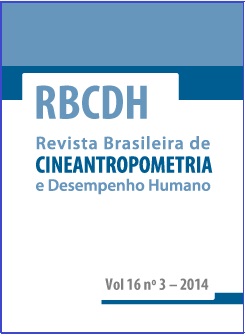Prática de caminhada no lazer e no deslocamento e associação com fatores socioeconômicos e ambiente percebido em adultos
DOI:
https://doi.org/10.1590/1980-0037.2014v16n3p345Resumen
O objetivo do presente estudo foi analisar a associação da prática de caminhada no domínio lazer e no domínio deslocamento com a percepção do ambiente em adultos residentes no município de Rio Claro - SP. Foi realizado um estudo transversal de base domiciliar com amostra composta por 470 adultos (45,7±17,8 anos). Os sujeitos responderam o Questionário Internacional de Atividades Físicas (versão longa) e uma versão adaptada da Escala de Mobilidade Ativa no Ambiente Comunitário, que foi utilizada para investigar a percepção do ambiente construído e social. Para análise dos dados foi realizada uma regressão logística, sendo considerado como desfecho, caminhar ?10minutos/semana no domínio lazer e no deslocamento. A prevalência de sujeitos que realizavam caminhada no lazer foi de 20,6% e 58,9% para a caminhada no deslocamento. A prevalência de caminhada no deslocamento entre as mulheres foi maior quando comparado com os homens (66,3% e 50,0%, respectivamente) e menor no domínio lazer (19,8% e 21,7%, respectivamente). A caminhada como forma de deslocamento foi associada com sexo feminino, classe econômica mais baixas (C, D e E) e percepção da disponibilidade da presença de faixa de pedestre. Para a caminhada no domínio lazer as variáveis pessoais e do ambiente que se associaram foram: idade (60 anos ou mais), classe econômica (B2, C, D e E), convite de amigos e/ou vizinhos para a prática. Os resultados apresentados demonstram que há uma associação entre a percepção do ambiente e a prática de caminhada no lazer e no deslocamento.
Descargas
Publicado
Número
Sección
Licencia

Direitos Autorais para artigos publicados nesta revista são do autor, com direitos de primeira publicação para a revista. Em virtude da aparecerem nesta revista de acesso público, os artigos são de uso gratuito, com atribuições próprias, em aplicações educacionais e não-comerciais, desde que seja dada a atribuição. Esta obra foi licenciada com uma Licença Creative Commons Atribuição 4.0 Internacional - CC BY


